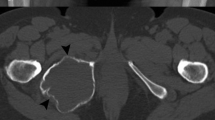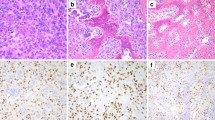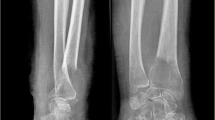Abstract
Giant cell tumor of bone (GCTB) is a benign tumor with a tendency for local recurrence. Secondary malignant GCTB is rare, occurring in less than 2 % of GCTB cases. Mechanisms of malignant transformation of GCTB remain unclear. We examined 43 cases of GCTB (38 conventional cases, two lung implantation cases, and three secondary malignant cases) for p53 gene mutations and for loss of heterozygosity (LOH) of p53 when corresponding normal tissue was available. In addition, to elucidate the possible involvement of p53, GPX-1, cyclinD1, and Ki-67 in malignant transformation of GCTB, we assessed the expression of these proteins by immunohistochemistry. Mutations or LOH of p53 were found in all three malignant cases, which also showed p53 overexpression. Non-synonymous p53 mutations were detected in seven of 38 conventional cases (18 %), although none of these showed p53 overexpression, defined as more than 10 % of cells being positive. LOH at the p53 locus was detected in eight of 37 informative cases, although this was not associated with p53 overexpression in conventional GCT. Expression of GPX-1 was higher in the recurrent group, which included metastatic and malignant cases, and patients with high GPX-1 expression were at greater risk for early relapse. We also observed a positive correlation between high p53 expression and high GPX-1 expression in GCTB. Given that GPX-1 is shown to be a target of p53, these results suggest that p53 mutations play a role in tumor recurrence and malignant transformation of GCTB through interactions with GPX-1.




Similar content being viewed by others
References
Bertoni F, Bacchini P, Staals EL (2003) Malignancy in giant cell tumor of bone. Cancer 97:2520–2529
Dorfman HD, Czerniak B (1998) Bone tumors. Mosby, St. Louis, pp 559–606
Niu X, Zhang Q, Hao L et al (2012) Giant cell tumor of the extremity: retrospective analysis of 621 Chinese patients from one institution. J Bone Joint Surg Am 94:461–467
Chanchairujira K, Jiranantanakorn T, Phimolsarnti R et al (2011) Factors of local recurrence of giant cell tumor of long bone after treatment: plain radiographs, pathology and surgical procedures. J Med Assoc Thai 94:1230–1237
Szendröi M, Kiss J, Antal I (2003) Surgical treatment and prognostic factors in giant-cell tumor of bone. Acta Chir Orthop Traumatol Cech 70:142–150
Errani C, Ruggieri P, Asenzio MA et al (2010) Giant cell tumor of the extremity: a review of 349 cases from a single institution. Cancer Treat Rev 36:1–7
Saito T, Mitomi H, Izumi H et al (2011) A case of secondary malignant giant-cell tumor of bone with p53 mutation after long-term follow-up. Hum Pathol 42:727–733
Saito T, Mitomi H, Suehara Y et al (2011) A case of de novo secondary malignant giant-cell tumor of bone with loss of heterozygosity of p53 gene that transformed within a short-term follow-up. Pathol Res Pract 207:664–669
Rao UNM, Goodman M, Chung WW, Swalski P, Pal R, Finkelstein S (2005) Molecular analysis of primary and recurrent giant cell tumors of bone. Cancer Genet Cytogenet 158:126–136
Gong L, Liu W, Sun X et al (2012) Histological and clinical characteristics of malignant giant cell tumor of bone. Virchows Arch 460:327–334
Conti A, Rodriguez GC, Chiechi A et al (2011) Identification of potential biomarkers for giant cell tumor of bone using comparative proteomics analysis. Am J Pathol 178:88–97
Saâda E, Peoc'h M, Decouvelaere AV et al (2011) CCND1 and MET genomic amplification during malignant transformation of a giant cell tumor of bone. J Clin Oncol 29:86–89
Gomes CC, Diniz MG, Orsine LA, Duarte AP, Fonseca-Silva T, Conn BI, De Marco L, Pereira CM, Gomez RS (2012) Assessment of TP53 mutations in benign and malignant salivary gland neoplasms. PLoS One 7:e41261
Bougeard G, Limacher JM, Martin C et al (2001) Detection of 11 germline inactivating TP53 mutations and absence of TP63 and HCHK2 mutations in 17 French families with Li-Fraumeni or Li-Fraumeni-like syndrome. J Med Genet 38:253–257
Takeuchi A, Tsuchiya H, Niu X et al (2011) The prognostic factors of recurrent GCT: a cooperative study by the Eastern Asian Musculoskeletal Oncology Group. J Orthop Sci 16:196–202
Tyler W, Barrett T, Frassica F et al (2002) Skin metastasis from conventional giant cell tumor of bone: conceptual significance. Skeletal Radiol 31:166–170
Rock MG, Pritchard DJ, Unni KK (1984) Metastases from histologically benign giant-cell tumor of bone. J Bone Joint Surg Am 66:269–274
Present DA, Bertoni F, Springfield D et al (1986) Giant cell tumor of bone with pulmonary and lymph node metastases. A case report. Clin Orthop Relat Res 209:286–291
Scotlandi K, Serra M, Manara MC et al (1995) Clinical relevance of Ki-67 expression in bone tumors. Cancer 75:806–814
Stenzel I, Posl M, Ritzel H et al (1996) Cell proliferation in bone tumors. Immunohistologic study of Ki-67 protein expression. Pathologe 17:56–62
Vollmer E, Roessner A, Wuisman P et al (1989) The proliferation behavior of bone tumors investigated with the monoclonal antibody Ki-67. Curr Top Pathol 80:91–114
Sulh MA, Greco MA, Jiang T et al (1996) Proliferation index and vascular density of giant cell tumors of bone: are they prognostic markers? Cancer 77:2044–2051
Ismail FW, Shamsudin AM, Wan Z et al (2010) Ki-67 immuno-histochemistry index in stage III giant cell tumor of the bone. J Exp Clin Cancer Res 29:25
Masui F, Ushigome S, Fujii K (1998) Giant cell tumor of bone: a clinicopathologic study of prognostic factors. Pathol Int 48:723–729
Papanastassiou I, Ioannou M, Papagelopoulos PJ et al (2010) P53 expression as a prognostic marker in giant cell tumor of bone: a pilot study. Orthopedics 33:329–15
Bridge JA, Neff JR, Bhatia PS et al (1990) Cytogenetic findings and biologic behavior of giant cell tumors of bone. Cancer 65:2697–2703
Gebre-Medhin S, Broberg K, Jonson T et al (2009) Telomeric associations correlate with telomere length reduction and clonal chromosome aberrations in giant cell tumor of bone. Cytogenet Genome Res 124:121–127
Kauzman A, Li SQ, Bradley G, Bell RS et al (2003) Cyclin alterations in giant cell tumor of bone. Mod Pathol 16:210–218
Ferracini R, Scotlandi K, Cagliero E et al (2000) The expression of Met/hepatocyte growth factor receptor gene in giant cell tumors of bone and other benign musculoskeletal tumors. J Cell Physiol 184:191–196
Smith LT, Mayerson J, Nowak NJ et al (2006) 20q11.1 amplification in giant-cell tumor of bone: array CGH, FISH, and association with outcome. Genes Chromosomes Cancer 45:957–966
Vogelstein B, Lane D, Levine AJ (2000) Surfing the p53 network. Nature 408:307–310
Prives C, Hall PA (1999) The p53 pathway. J Pathol 187:112–126
Soussi T, Beroud C (2001) Assessing TP53 status in human tumours to evaluate clinical outcome. Nat Rev Cancer 1:233–240
Seemann S, Maurici D, Olivier M et al (2004) The tumor suppressor gene TP53: implications for cancer management and therapy. Crit Rev Clin Lab Sci 41:551–583
Rao UN, Goodman M, Chung WW et al (2005) Molecular analysis of primary and recurrent giant cell tumors of bone. Cancer Genet Cytogenet 158:126–136
Wu Y, Hsiu J, Lou Y et al (1997) p53 protein accumulation and genetic alterations in human giant cell tumors of bone (osteoclastomas). Int J Oncol 10:1087–1092
Oda Y, Sakamoto A, Saito T et al (2001) Secondary malignant giant cell tumor of bone: molecular abnormalities of p53 and H-ras gene correlated with malignant transformation. Histopathology 39:629–637
Pazzaglia L, Conti A, Chiechi A et al (2010) Differential gene expression in classic giant cell tumours of bone: Tenascin C as biological risk factor for local relapses and metastases. Histopathology 75:59–72
Nenutil R, Smardova J, Pavlova S et al (2005) Discriminating functional and non-functional p53 in human tumours by p53 and MDM2 immunohistochemistry. J Pathol 207:251–259
Bi S, Lanza F, Goldman JM (1993) The abnormal p53 proteins expressed in CML cell lines are non-functional. Leukemia 7:1840–1845
Sakai T, Furihata T, Kawamata H et al (2002) Molecular and genetic characterization of a non-metastatic human esophageal cancer cell line, T.Tn expressing non-functional mutated p53. Int J Oncol 21:547–552
Hussain SP, Amstad P, He P et al (2004) p53-induced upregulation of MnSOD and GPx but not catalase increases oxidative stress and apoptosis. Cancer Res 64:2350–2356
Ueda S, Masutani H, Nakamura H et al (2002) Redox control of cell death. Antioxid Redox Signal 4:405–414
Mori K, Shibanuma M, Nose K (2004) Invasive potential induced long-term oxidative stress in mammary epithelial cells. Cancer Res 64:7464–7472
Gouazè V, Mirault ME, Carpentier S et al (2001) Glutathione peroxidase-1 overexpression prevents ceramide production and partially inhibits apoptosis in doxorubicin-treated human breast carcinoma cells. Mol Pharmacol 60:488–496
Jänicke RU, Sohn D, Schulze-Osthoff K (2008) The dark side of a tumor suppressor: anti-apoptotic p53. Cell Death Differ 15:959–976
Matsubayashi S, Nakashima M, Kumagai K et al (2009) Immunohistochemical analyses of beta-catenin and cyclin D1 expression in giant cell tumor of bone (GCTB): a possible role of Wnt pathway in GCTB tumorigenesis. Pathol Res Pract 205:626–633
Acknowledgments
We greatly appreciate the help of Keiko Mitani and Michiko Takahashi at the Department of Human Pathology, Juntendo University School of Medicine. This work was supported in part by a Grant-in-Aid for General Scientific Research from the Ministry of Education, Science, Sports and Culture (#23590434 to Tsuyoshi Saito and #24590429 to Hiroyuki Mitomi), Tokyo, Japan.
Author information
Authors and Affiliations
Corresponding author
Rights and permissions
About this article
Cite this article
Okubo, T., Saito, T., Mitomi, H. et al. p53 mutations may be involved in malignant transformation of giant cell tumor of bone through interaction with GPX1. Virchows Arch 463, 67–77 (2013). https://doi.org/10.1007/s00428-013-1435-z
Received:
Revised:
Accepted:
Published:
Issue Date:
DOI: https://doi.org/10.1007/s00428-013-1435-z




